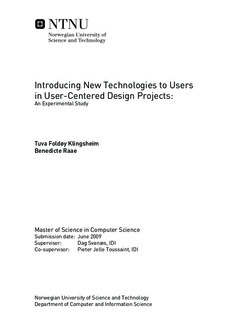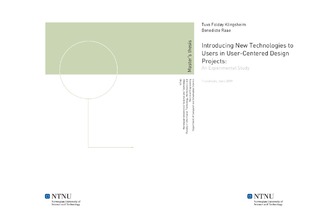| dc.contributor.advisor | Svanæs, Dag | nb_NO |
| dc.contributor.advisor | Toussaint, Pieter Jelle | nb_NO |
| dc.contributor.author | Klingsheim, Tuva Foldøy | nb_NO |
| dc.contributor.author | Raae, Benedicte | nb_NO |
| dc.date.accessioned | 2014-12-19T13:33:56Z | |
| dc.date.available | 2014-12-19T13:33:56Z | |
| dc.date.created | 2010-09-04 | nb_NO |
| dc.date.issued | 2009 | nb_NO |
| dc.identifier | 348770 | nb_NO |
| dc.identifier | ntnudaim:4670 | nb_NO |
| dc.identifier.uri | http://hdl.handle.net/11250/251337 | |
| dc.description.abstract | In user-centered design the users play an important role in the development process. The users are included in near every step of the process and it is often a problem that they do not have the necessary overview of a technology intended used in the end system. They do not need to know all the technical details, but they do need to know what possibilities the technology makes available. To do this one needs to introduce the users to the technical possibilities, but how does one do this? We had two suggestions as to how this could be done. We proposed introducing the possibilities through abstract concepts not tied to the users' domain. The reason being we did not want to lock the users to concrete ideas given by us, but let them use the abstract concepts to come up with ideas in their own domain. The other suggestion was giving the users hands-on experience with the concepts. Human knowledge is usually derived from experience, and we believe touching and trying out the possibilities of a technology would also be helpful in this kind of setting. To test whether hands-on experience and abstract concepts is valuable in an introduction of new technologies we conducted an experiment involving two workshops. Both workshops got a theoretical presentation of the abstract concepts, while one workshop let the participants explore a demonstrator made by us giving them hands-on experience. These workshops were then analyzed both qualitatively and quantitatively. The quantitative analysis showed that the workshop incorporating hands-on experience generated more unique ideas and also ideas in more categories than the other workshop. However due to low comparability between the groups due to factors such as prior experience with the technologies and current work situation, we do not give these findings much significance. Through the qualitative analysis we see that hands-on experience can be valuable. For one participant in particular, the hands-on experience was very valuable. In addition we found it valuable as a motivational exercise in a user-centered design process. The abstract concepts were analyzed qualitatively, and these were not as valuable as hoped. The users found it hard to map the abstract concepts to their domain. We now see the value of examples closer to the users' domain, but they should be kept as small building blocks for the users to combine to solve larger problems. We end this paper with a suggested approach to introducing new technological possibilities. We still recommend using the abstract concepts, but taking care to exemplify them through many small domain-specific examples. Hands-on experience is recommended if it is feasible to do this within the domain. We also recommend for time to mature and revisiting the participant after they've been back in their domain for a while. | nb_NO |
| dc.language | eng | nb_NO |
| dc.publisher | Institutt for datateknikk og informasjonsvitenskap | nb_NO |
| dc.subject | ntnudaim | no_NO |
| dc.subject | SIF2 datateknikk | no_NO |
| dc.subject | Data- og informasjonsforvaltning | no_NO |
| dc.subject | Program- og informasjonssystemer | no_NO |
| dc.title | Introducing New Technologies to Users in User-Centered Design Projects:: An Experimental Study | nb_NO |
| dc.type | Master thesis | nb_NO |
| dc.source.pagenumber | 86 | nb_NO |
| dc.contributor.department | Norges teknisk-naturvitenskapelige universitet, Fakultet for informasjonsteknologi, matematikk og elektroteknikk, Institutt for datateknikk og informasjonsvitenskap | nb_NO |

